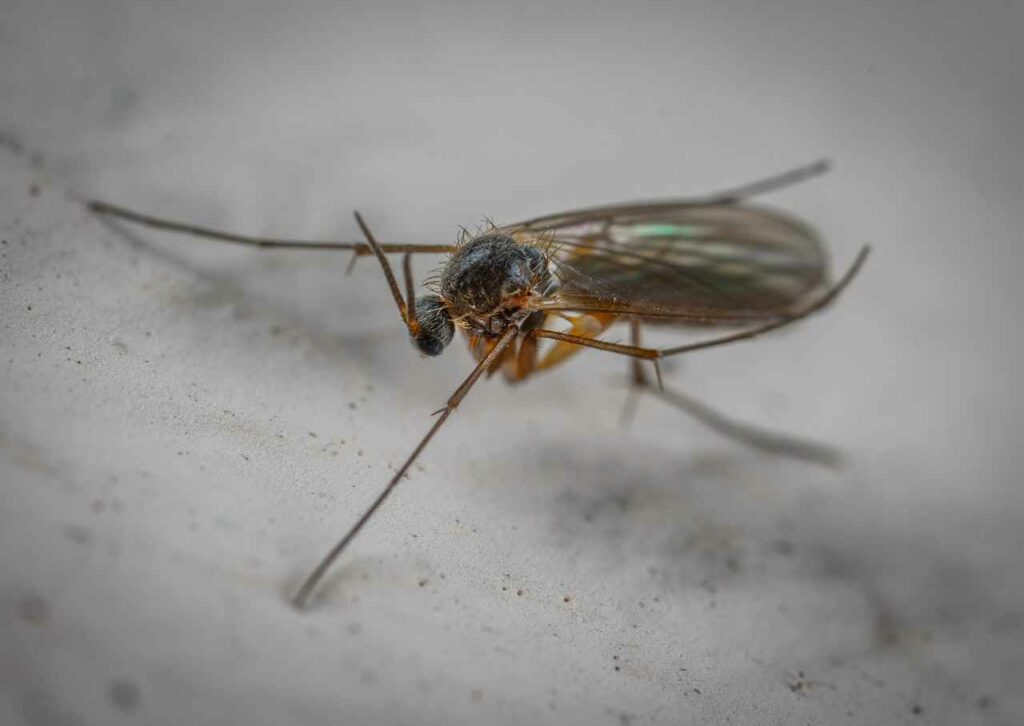Gnats in a bedroom can be caused by several factors, including:
- Attraction to sweet scents from fruit, moisture, garbage, or houseplants
- Presence of damp soil in potted plants
- Moisture or stagnant water around the home
- Unsealed produce, fresh flowers, food spillage, or open/overflowing garbage cans
To prevent gnats, ensure proper sanitation, avoid overwatering plants, and eliminate moisture or stagnant water sources.
How Can You Identify If The Presence Of Gnats In Your Bedroom Is Due To The Attraction To Sweet Scents?
To identify if the presence of gnats in your bedroom is due to the attraction to sweet scents, you can check if there are any sweet-smelling items in your room, such as fruits, flowers, or perfumes.
Gnats are attracted to sweet and fruity scents, so removing these items or keeping them at a minimum can help reduce the attraction of gnats to your bedroom.
Additionally, gnats have a keen sense of smell and use odour receptor organs on their antennae to detect and fly towards odours produced by sweet scents.
Are There Any Particular Types Of Fruit Or Houseplants That Tend To Attract Gnats More Than Others?
There is no clear evidence that any particular type of fruit or houseplant attracts gnats more than others.
However, gnats are attracted to rotting organic debris in potting soil, so they are a common problem for plant lovers.
Fungus gnats are attracted to sewage-contaminated soil, garbage, drains, rotting vegetables, and fruit, while phorid flies are attracted to sewage-contaminated soil, garbage, drains, and rotting vegetables and fruit.
Fruit flies, on the other hand, are often found in the kitchen, feeding on overripe fruits.
What Can You Do To Eliminate Sources Of Stagnant Water In Your Home And Prevent The Growth Of Gnats?
To eliminate sources of stagnant water in your home and prevent the growth of gnats, you can take the following steps:
- Clean your sinks and drains regularly using a pipe brush and your usual cleaning solution
- Dispose of overripe fruit and produce past its prime
- Avoid overwatering plants and ensure the top layer of soil is not constantly wet
- Water plants over a sink or drain and let the excess water drain away
- Use chamomile and cinnamon, which are natural fungicides, to make the soil inhospitable to gnats
- Use traps with vinegar and dish soap to catch gnats
- Use any product that will break down the slime or organic matter that is building up in the pipes to prevent gnats in the long term
Are There Any Natural Remedies Or Products That Can Be Used To Repel Or Eliminate Gnats In A Bedroom?
There are several natural remedies and products that can be used to repel or eliminate gnats in a bedroom.
Some of these include:
- Homemade traps made of vinegar, soap, and sugar, or red wine and dish soap
- Homemade gnat-repellent spray made of dish soap, water, baking soda, and vinegar
- Apple cider vinegar gnat trap made of apple cider vinegar, dish soap, and sugar
- Spraying a mixture of water, vinegar, and soap
- Throwing away old food and storing fruit in the fridge
- Using flypaper or hiring an exterminator
It is important to note that the effectiveness of these remedies may vary depending on the severity of the infestation.
Can The Presence Of Gnats In A Bedroom Be A Sign Of A More Significant Pest Problem, And How Can You Determine If This Is The Case?
The presence of gnats in a bedroom can signify a more significant pest problem, but it is not always the case.
Gnats are attracted to moist environments, so it is essential to keep the room dry and well-ventilated.
To determine if there is a more significant pest problem, it is recommended to look for other signs of infestation, such as faecal matter, damage to fabrics or wood, or other insects.
If there are other signs of infestation, it is best to call a professional pest control company.
However, if the gnats are only present in small numbers, it is possible to get rid of them using DIY methods such as vinegar traps, sprays, or sticky traps.







